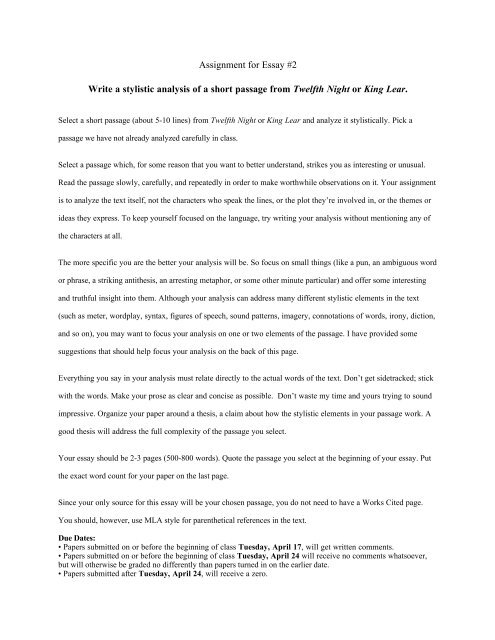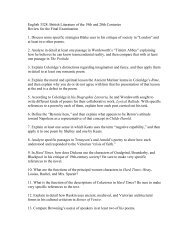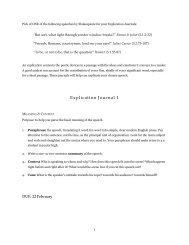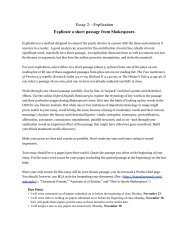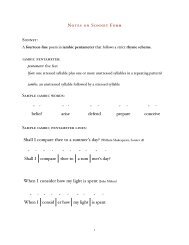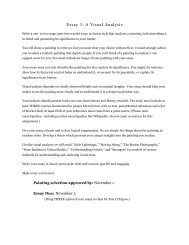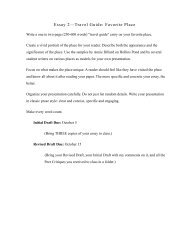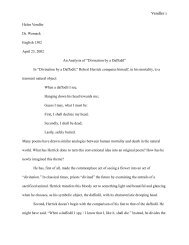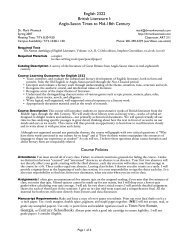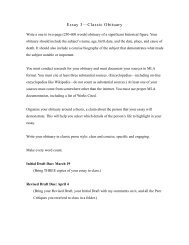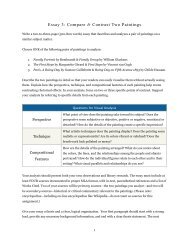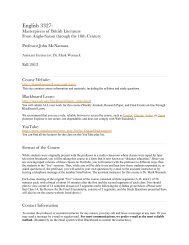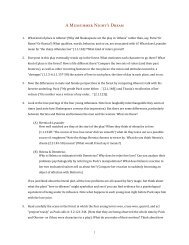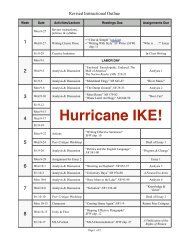Assignment for Essay #2 Write a stylistic analysis ... - Dr. Mark Womack
Assignment for Essay #2 Write a stylistic analysis ... - Dr. Mark Womack
Assignment for Essay #2 Write a stylistic analysis ... - Dr. Mark Womack
You also want an ePaper? Increase the reach of your titles
YUMPU automatically turns print PDFs into web optimized ePapers that Google loves.
<strong>Assignment</strong> <strong>for</strong> <strong>Essay</strong> <strong>#2</strong><br />
<strong>Write</strong> a <strong>stylistic</strong> <strong>analysis</strong> of a short passage from Twelfth Night or King Lear.<br />
Select a short passage (about 5-10 lines) from Twelfth Night or King Lear and analyze it <strong>stylistic</strong>ally. Pick a<br />
passage we have not already analyzed carefully in class.<br />
Select a passage which, <strong>for</strong> some reason that you want to better understand, strikes you as interesting or unusual.<br />
Read the passage slowly, carefully, and repeatedly in order to make worthwhile observations on it. Your assignment<br />
is to analyze the text itself, not the characters who speak the lines, or the plot they’re involved in, or the themes or<br />
ideas they express. To keep yourself focused on the language, try writing your <strong>analysis</strong> without mentioning any of<br />
the characters at all.<br />
The more specific you are the better your <strong>analysis</strong> will be. So focus on small things (like a pun, an ambiguous word<br />
or phrase, a striking antithesis, an arresting metaphor, or some other minute particular) and offer some interesting<br />
and truthful insight into them. Although your <strong>analysis</strong> can address many different <strong>stylistic</strong> elements in the text<br />
(such as meter, wordplay, syntax, figures of speech, sound patterns, imagery, connotations of words, irony, diction,<br />
and so on), you may want to focus your <strong>analysis</strong> on one or two elements of the passage. I have provided some<br />
suggestions that should help focus your <strong>analysis</strong> on the back of this page.<br />
Everything you say in your <strong>analysis</strong> must relate directly to the actual words of the text. Don’t get sidetracked; stick<br />
with the words. Make your prose as clear and concise as possible. Don’t waste my time and yours trying to sound<br />
impressive. Organize your paper around a thesis, a claim about how the <strong>stylistic</strong> elements in your passage work. A<br />
good thesis will address the full complexity of the passage you select.<br />
Your essay should be 2-3 pages (500-800 words). Quote the passage you select at the beginning of your essay. Put<br />
the exact word count <strong>for</strong> your paper on the last page.<br />
Since your only source <strong>for</strong> this essay will be your chosen passage, you do not need to have a Works Cited page.<br />
You should, however, use MLA style <strong>for</strong> parenthetical references in the text.<br />
Due Dates:<br />
• Papers submitted on or be<strong>for</strong>e the beginning of class Tuesday, April 17, will get written comments.<br />
• Papers submitted on or be<strong>for</strong>e the beginning of class Tuesday, April 24 will receive no comments whatsoever,<br />
but will otherwise be graded no differently than papers turned in on the earlier date.<br />
• Papers submitted after Tuesday, April 24, will receive a zero.
1. Read the passage <strong>for</strong> meaning. Pay attention to the sentence, not the line, as the principal unit of organization.<br />
Find the subject and verb. Forget, <strong>for</strong> the moment, about the poetry.<br />
2. Try to summarize the main idea or ideas. (Do this in writing: having to commit conclusions to paper <strong>for</strong>ces you<br />
to decide what you think. Don't include your summary in your essay.)<br />
3. Outline the progression of ideas, identifying major sections. Is there a clear system of organization Are there<br />
antitheses (there usually are in Shakespeare) Repetitions Indirections<br />
4. Is irony a factor Is there, in other words, a discrepancy between the speaker's words and meanings<br />
5. Examine the diction of the passage. After reading <strong>for</strong> denotation (straight<strong>for</strong>ward meaning), think about<br />
connotation. Look up important words in the Ox<strong>for</strong>d English Dictionary to determine their currency in the<br />
Renaissance and to discover implied significance. Notice connections among roots or words, as well as<br />
alternative or archaic (but still applicable) meanings.<br />
6. Think about wordplay, remembering that puns need not be funny. Consider multiple senses of words.<br />
7. Notice imagery. Is it particularly abundant unusually sparse Do the images suggest patterns or <strong>for</strong>m clusters<br />
How do the images promote or clarify the subject<br />
8. What about figurative language: similes, metaphors, symbols Analyze metaphors with an eye on the tenor (the<br />
thing being described), the vehicle (the thing used to describe it), and the connotations of the comparison.<br />
9. Are there classical, biblical, or historical allusions What do they contribute<br />
10. Do you find understatement, hyperbole, personification, paradox<br />
11. Study the syntax, the arrangement of words into sentences. Is word order normal or inverted Do sentences<br />
seem simple or complex<br />
12. Examine meter as you have syntax. Is it regular or not Look <strong>for</strong> run-on lines or important instances of caesura.<br />
13. Pay attention to musical devices such as alliteration, rhyme, assonance, consonance, euphony, cacophony,<br />
onomatopoeia. How do they contribute to the passage’s effect on a reader<br />
14. For every device, the essential question is “How does it work”


